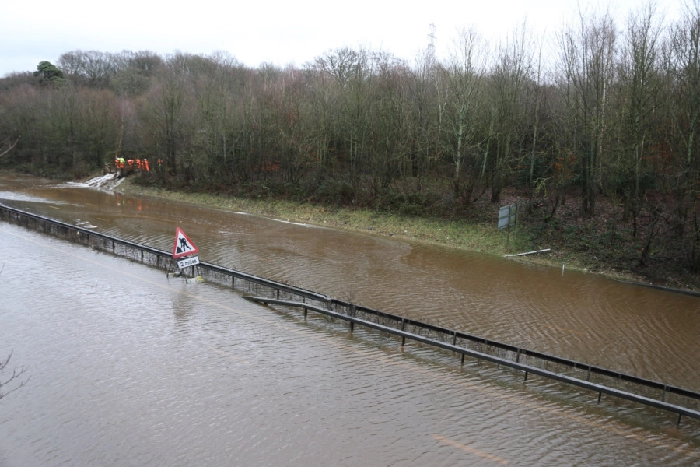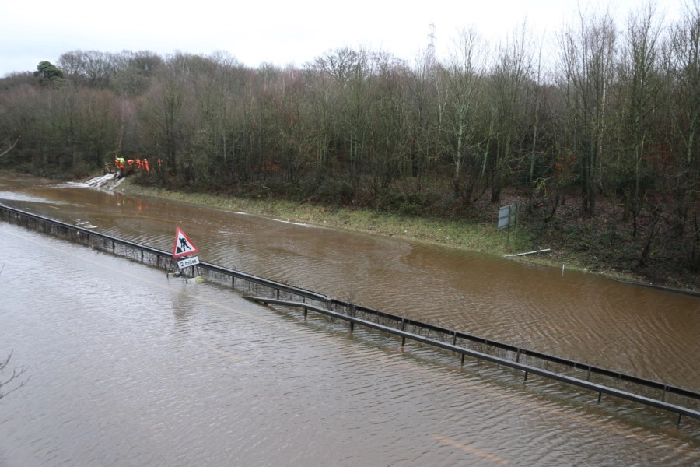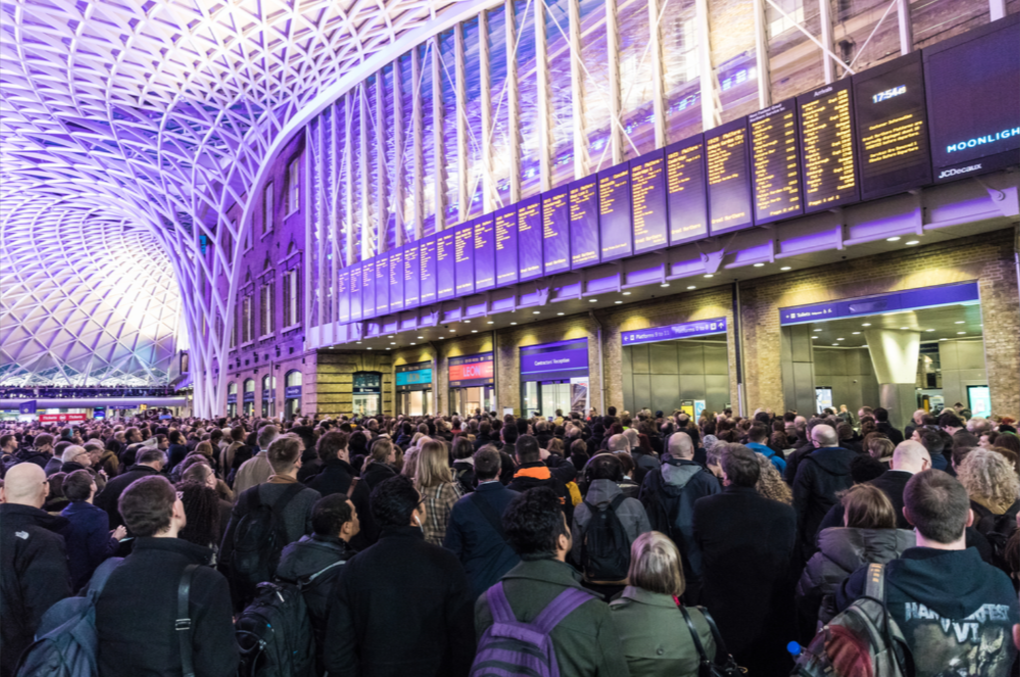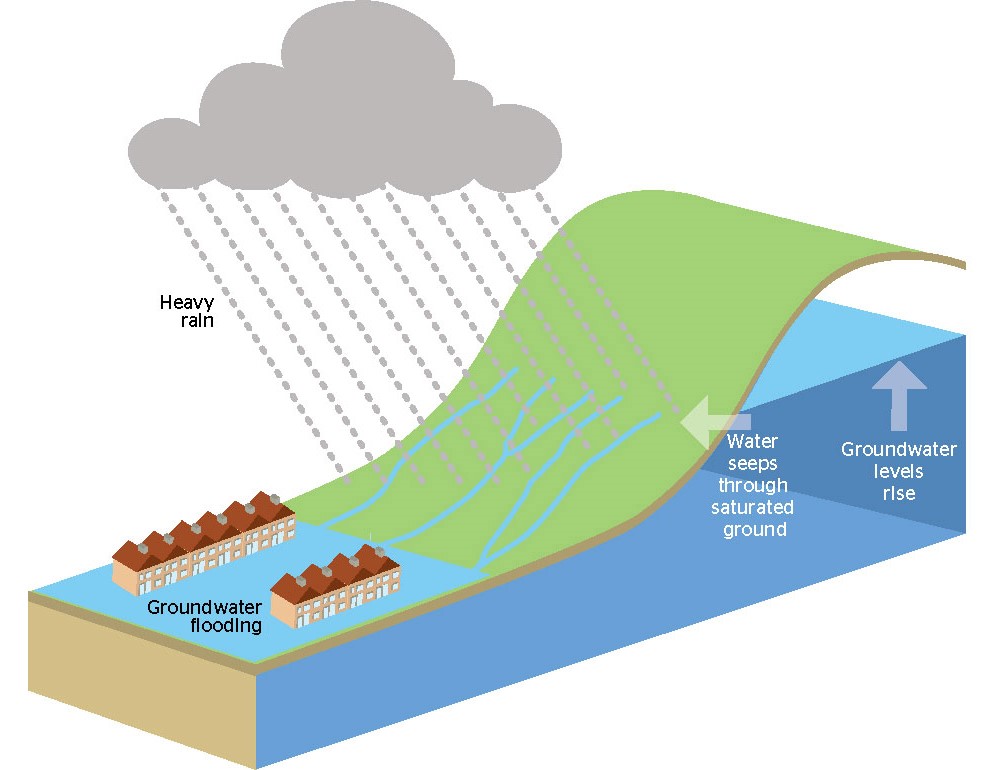Christmas flooding and its effect on Groundwater

The Friday before Christmas is one of the busiest travel days of the year as hundreds of thousands of people frantically try and return home with bags full of presents and minds full of Christmas cheer.
However, this festive season, this annual migration was disrupted because of excessive flooding which hit Sussex and the South East of England.
The heavy rain persisted for several days on the run up to Christmas. The heavy downpours continued which led to increased flood risk and rising river levels in the river Mole, Medway and the Stour, in Sussex. Nationally, the Environment Agency issued over 91 flood warnings1, 83 of which were in the South East2. The rain endured, finally leading to disaster as the river Mole burst its banks, on the 20th of December3. Large areas of the South East became severely flooded including both carriageways of the M23 between junctions 10 and 11.

Workmen fighting the flooded M23 on the 20th December 2019.9
It also flooded the railways with services from Southern Rail, Thameslink and Gatwick Express all being cancelled and major disruption on all Brighton to London lines3 I can speak personally about the chaos this caused for people travelling home for Christmas, as Groundsure is based in Brighton and on the 20th December, I was travelling up to North Yorkshire by train.

A busy Kings Cross station, London.
Between the 7th and the 23rd December 130-150mm of rain was measured across Sussex, which equates to approximately 140% of the long-term average for the whole of December. Furthermore, nearly a third of Decembers measured rain fell in just two days (the 21st and 22nd December)4. These heavy downpours on the run up to Christmas caused localised surface water flooding and river flooding across the South East. As the rain finally relented, the river levels and the areas of surface water flooding decreased. However, this rain will have lasting affect on the groundwater levels in the region, which could ultimately lead to more flooding. Groundwater flooding is caused by unusually high groundwater levels. It typically occurs after intense periods of rainfall, as excess water drains into the ground, the aquifers become saturated and the water table rises above the land surface. It often emerges at the ground surface or within topographical low spots including underground structures such as basements. Groundwater flooding tends to be more persistent than surface water flooding or river flooding, in some cases lasting for weeks or months, and it can result in significant damage to property.

Diagram of Groundwater flooding, Southern Water.10
Since Christmas, the rain in the South East has decreased however groundwater levels remain high in localised areas, even into the start of 2020. The Environment Agency issued groundwater flood alerts for multiple areas in Sussex following the rain including both the Upper Lavant Valley (Chilgrove, West Dean, Singleton, Charlton, East Dean) and Patcham, and many of these areas still have alerts and warnings in place4. Potential impacts vary from area to area, however, commonly these will include; water in cellars or basements, springs appearing and water flowing down rural roads. The impacts of groundwater may continue to develop and intensify over the coming weeks as it is very much a possibility that there will be further extended periods of rainfall that could result in more flood events across the South East and the UK. Especially, as the level of the water table is currently high, the risk from groundwater flooding is increased, therefore it is possible flooding will occur again causing further disruption.
It is extremely difficult to predict the long-term effects and there is always uncertainty associated with predicting weather systems. As our climate changes we are going to feel more of the detrimental impact of flooding within the UK. Previous research has already suggested that flood events in the UK have been influenced by human-induced warming5,6. It is expected that the intensity and tendency of flood events will increase in the UK, and precipitation in the winter months may increase as much as 33%7. It took me roughly two hours extra on my journey to get to North Yorkshire on the Friday before Christmas, which was not the end of the world. Research has suggested that flood risk may increase by a factor of almost 30 times, because of human induced of climate change, and that tradition engineering measures to tackle flood risk may prove inadequate to deal with this monumental shift8. Therefore, situations like this are going to become more frequent and the impacts of flooding throughout the UK are likely to be much more severe in years to come. Therefore, it is going to be of increased importance to try and predict flood risk to properties, businesses and infrastructure in the future using flood risk assessments.
How can Groundsure help?
Before proceeding with any property transaction, a number of environmental risks including flooding should be investigated fully. In line with the Law Society Practice Note on Flood Risk, Groundsure’s reports provide a comprehensive assessment of risk, as well as giving a view on the likely availability of affordable insurance, via Ambiental Risk Analytics FloodScore™. It is imperative anyone involved with property transactions fully investigates whether flood risk is included within the buildings insurance policy.
References
1. ITV News. (2020). Parts of Kent and Sussex under water as 91 flood warnings issued. [online] Available at: https://www.itv.com/news/meridian/2019-12-22/parts-of-kent-and-sussex-under-water-as-91-flood-warnings-issued/ [Accessed 2 Jan. 2020].
2. GOV.UK. (2020). Heavy rain increases flood-risk across South East. [online] Available at: https://www.gov.uk/government/news/heavy-rain-increases-flood-risk-across-south-east [Accessed 2 Jan. 2020].
3. BBC News. (2020). Flooding brings travel disruption to South East. [online] Available at: https://www.bbc.co.uk/news/uk-england-50863956 [Accessed 2 Jan. 2020].
4. Environment Agency. (2020) Assets.publishing.service.gov.uk. (2020). [online] Available at: https://assets.publishing.service.gov.uk/government/uploads/system/uploads/attachment_data/file/854971/Sussex_GW_Briefing_Note_2019_12_23.pdf [Accessed 3 Jan. 2020].
5. Otto, F., van der Wiel, K., van Oldenborgh, G., Philip, S., Kew, S., Uhe, P. and Cullen, H. (2018). Climate change increases the probability of heavy rains in Northern England/Southern Scotland like those of storm Desmond—a real-time event attribution revisited. Environmental Research Letters, 13(2), p.024006.
6. Kay, A., Booth, N., Lamb, R., Raven, E., Schaller, N. and Sparrow, S. (2018). Flood event attribution and damage estimation using national-scale grid-based modelling: Winter 2013/2014 in Great Britain. International Journal of Climatology, 38(14), pp.5205-5219
7. Reynard, N., Prudhomme, C. and Crooks, S. (2001). Climatic Change, 48(2/3), pp.343-359.
8. Ashley, R., Balmforth, D., Saul, A. and Blanskby, J. (2005). Flooding in the future – predicting climate change, risks and responses in urban areas. Water Science and Technology, 52(5), pp.265-273.
9. M23 flooding: Motorway to ‘remain closed for several hours’ [online] Available at: https://www.wscountytimes.co.uk/news/people/m23-flooding-motorway-to-remain-closed-for-several-hours-1-9180824 [Accessed 2 Jan. 2020].
10. Diagram of Groundwater flooding, Southern Water https://www.southernwater.co.uk/help-advice/flooding
Date:
Jan 13, 2020
Author:
Patrick Hepple

